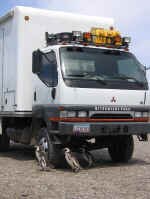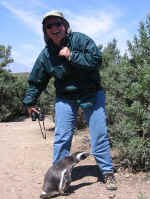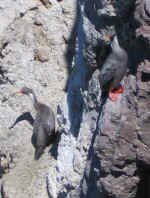|
January 1 - 6, 2006 - Puerto Deseado After a beautiful New Year's Eve spent exploring Punta Ninfas, New Year's day morning was spent hurrying to get back to a paved road. It had started thundering around sunrise, so we knew we needed to get moving. It rained on and off for the two hours it took us to get back to the pavement and the road just kept getting muckier and muckier. We finally made it, but with about 100 extra pounds of mud attached to every surface underneath the cabin body. We stopped in the town of Rawson and found a hose to clean off the bottom of the truck. What a mess! Considerably cleaner, we continued on to the lovely town of Gaiman. Gaiman was settled in 1874 by Welsh immigrants and is famous for its tea-houses. Since they are only open in the afternoon, our timing was right to visit one of the largest, Ty Caerdydd. Set amongst its own fields, the tea house grows the fruits that are used in their cakes and sweets. For $6.50US, you can eat as many pastries as you care to and drink as much tea as you can. It was a decadent way to start a new year. So much for diets! When we left, the locals were lined up in front of the bakery to buy sweets to take home. The next day we visited Gaiman's Paleontology Museum. This outdoor museum has a trail that winds through the formations where fossilized insects, fish and mammals have been discovered. Set at various levels along the trail are displays of what was found at that level. It was a very nicely done museum, and the light rain that fell failed to deter our exploration. Moving on to the city of Trelew, we also visited their Paleontology Museum. The Chubut region of Patagonia has been the site of many dinosaur finds and the museum has them well documented. Their dinosaur skeletons are absolutely amazing. They also had a very interesting video about Patagonia's role in advancing man's knowledge of the mid-Jurassic period. After doing some stocking up, we headed for the coast. The Punta Tombo Provincial Reserve is South America's largest single penguin colony. Half a million penguins come ashore here in the spring (October to December) to nest and give birth. The park is remote, but worth the drive. Immediately after passing the entrance gate, we began to see penguins. Penguins on the road, penguins in burrows, penguins on hillsides, penguins walking, penguins swimming, penguins everywhere. Finally making our way to the parking area, we walked along the marked trails to have up close and personal experiences with penguins. People are supposed to stay to the path so as not to disturb the penguins, but nobody told the penguins the rules. And they are everywhere! There is no way that you could come here and not have a penguin encounter. They are incredibly inquisitive and are as interested in you as you are in them. And when you get ready to leave, it is imperative that you check under your car before driving away, because they'll be checking out the underside of it. Continuing on down the coast, we visited the ghost town of Cabo Raso. There were only a few abandoned buildings there, and as we were wandering around, the caretaker asked us for help getting his car running. His needed a jump start, so we pulled his car down the beach behind the Fuso until it started. We don't know how long he had been waiting for someone to come by, but we drove for two hours on the road without seeing another car. We were happy to help him out, because you never know when you might be the one needing help! We spent the night camped on the beach. In the morning we helped our friend start his car again, then headed out to reach the main highway. Along the way we got a bit more four wheeling in as we crossed many arroyos, many with water flowing from the storms of the past few days. We also tried not to load our Fuso down with too much excess mud! Over the past week we have driven about 250 miles off pavement and it was nice to hit paved roads again - just for a break. We stayed the night just off the beach in the small town of Rada Tilly in another nice municipal campground. We have found that Argentines enjoy the outdoors and do a lot of camping, so most towns have an inexpensive campground. In the morning we did our mundane things like filling up on water, grocery shopping and this time, filling up our propane bottle for our stove. We carry enough propane to get us through a minimum of two months on the road. After our difficult experience of finding propane in Brazil, we were not looking forward to our first fill in Argentina. However, the campground host gave us great directions to a supplier just a few miles away and when we arrived, the whole process took less than 20 minutes. Excellent! Continuing our drive south, the highway followed the coastline providing us with great vistas of the rocky coast. Crossing the province border into Santa Cruz, we had another police stop where we expected to get asked again if we were carrying produce and meat. Instead, we had to "register", providing our vehicle registration papers, name and country of origin. This was different, but not difficult. The rest of our day we drove along wide open, desolate land reaching the town of Puerto Deseado. The attraction here is the Reserva Natural Rķa Deseado. The river dried up, leaving an empty river bed that was reclaimed by the ocean. It is now basically a bay that besides serving as the country's main shrimp fleet port, also has tremendous wildlife viewing opportunities. We were hoping to join a tour out to an island that has the only South American colony of Rock Hopper Penguins. These penguins have great yellow eyebrows and a tuft of feathers that give them a "Don King" look. Unfortunately the weather made the ocean too rough to travel to their island home. Lucky for us, the tourist information office provided us with an alternative drive that we could take traveling back up the "river" bed, across flooded canyons and close to other penguin and bird colonies.
Afterwards we returned to our camp at the muni-campground, again on the beach, where we wrote up this entry at sunset - 9:20 PM! We are currently at a latitude of 47° (degrees) South. Compare this with North America and we are as far south as Alaska is north.
|


